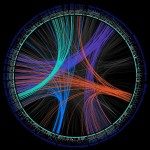Lien vers Pubmed [PMID] – 22968131
Eur. J. Hum. Genet. 2013 Apr;21(4):415-22
Homogeneous Proto-Slavic genetic substrate and/or extensive mixing after World War II were suggested to explain homogeneity of contemporary Polish paternal lineages. Alternatively, Polish local populations might have displayed pre-war genetic heterogeneity owing to genetic drift and/or gene flow with neighbouring populations. Although sharp genetic discontinuity along the political border between Poland and Germany indisputably results from war-mediated resettlements and homogenisation, it remained unknown whether Y-chromosomal diversity in ethnically/linguistically defined populations was clinal or discontinuous before the war. In order to answer these questions and elucidate early Slavic migrations, 1156 individuals from several Slavic and German populations were analysed, including Polish pre-war regional populations and an autochthonous Slavic population from Germany. Y chromosomes were assigned to 39 haplogroups and genotyped for 19 STRs. Genetic distances revealed similar degree of differentiation of Slavic-speaking pre-war populations from German populations irrespective of duration and intensity of contacts with German speakers. Admixture estimates showed minor Slavic paternal ancestry (~20%) in modern eastern Germans and hardly detectable German paternal ancestry in Slavs neighbouring German populations for centuries. BATWING analysis of isolated Slavic populations revealed that their divergence was preceded by rapid demographic growth, undermining theory that Slavic expansion was primarily linguistic rather than population spread. Polish pre-war regional populations showed within-group heterogeneity and lower STR variation within R-M17 subclades compared with modern populations, which might have been homogenised by war resettlements. Our results suggest that genetic studies on early human history in the Vistula and Oder basins should rely on reconstructed pre-war rather than modern populations.

